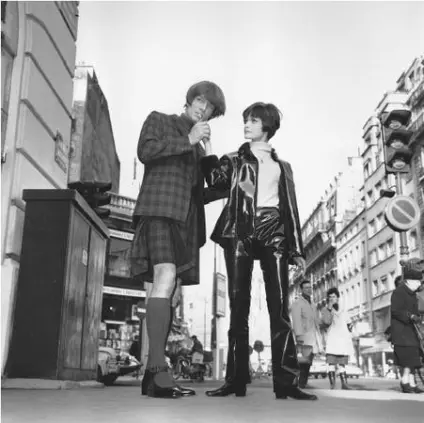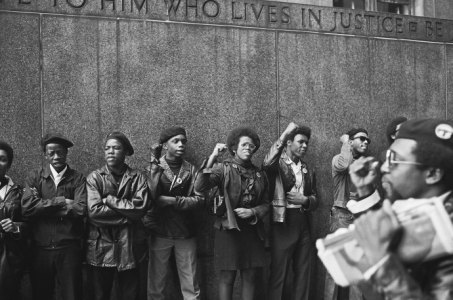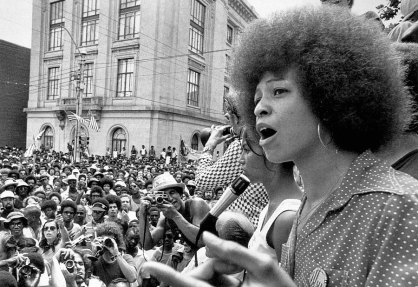Below are two more papers that will be presented this coming Saturday May 7th at The Annual Research Symposium of the Fashion and Textiles: History, Theory, Museum Practice Program at FIT’s School of Graduate Studies.
JACQUES ESTEREL’S 1971 COLLECTION AND THE GENDER CRISIS OF THE 1970S
By Ilene Hacker

Jacques Esterel, 1966 collections: “Mironton” (left), a Scottish-style plaid kilt ensemble, and “False Brother” (right), a vinyl pantsuit with zipped jacket ensemble.
© AP/Wide World Photos.
On May 3, 1968, student protests erupted in Paris in response to the conservative and outmoded system of Charles de Gaulle’s post-War France. Factory workers joined the protest in a move that eventually brought the country to a halt. The events of May 1968 led to a social upheaval, especially in regards to gender issues. “The notion of a stable masculine ‘norm,’ that underpinned so many cultural ideas in the West, was dismantled by the shifting definitions of femininity, no longer seen as an ‘opposite’ that would remain poles apart from the ideals of strength, independence and rationality, previously viewed as the sole prerogative of men.”
The Parisian couturier Jacques Esterel, known most famously for designing Brigitte Bardot’s wedding dress, launched a couture unisex collection in February 1971. The Institut National Audiovisuel in France has video footage of Esterel presenting the collection. “Alice 71 in Wonderland” is partially narrated by Esterel, who lends insight not only into his own thought process but also the collective spirit of the post-1960s generation.
In the opening sequence, a male and female model walk hand-in-hand, smiling brightly and both wearing dresses. “If I am attempting to dress men not as women, but rather put men in dresses, it does not mean that they have to, but that they can if they want to. It is just another door towards freedom.” Unisex dressing represented a utopian dream for many, who were striving to achieve universal equality.
In this paper, I will use “Alice 71 in Wonderland” as a framework for analyzing the breakdown of the fashion system and the gender issues that resulted from the events of May 1968, as seen in extant garments, photographs, interviews and articles, and supporting the conclusion that periods of crisis are not only foreshadowed by, but also directly result in, changes in systems of dress.
IMAGINING A REVOLUTION: A CASE STUDY, THE BLACK PANTHER PARTY
By Elisa Koizumi

Black Panthers in New York City. Photograph by David Fenton / Getty
Dress, the silent messenger, is one of society’s most powerful communicators. The message is purely visual, and relies on how it resonates with the observer. Further interactions are often informed by how one curates himself. Society relies on codified systems of dress, dictated by tradition, class, gender, age, environment or any combination of, and imposes a degree of expected adherence in order for the individual to be accepted. These are the norms that create cohesion within the societal groups.

Angela Davis of the The Black Panthers Party
Throughout history crisis events have caused upheaval to present patterns of dress, forcing new, or limited choices, thus creating change. For instance, war can choke supply, strong religious shifts might compel modesty, or a personal event can impact the contents of one’s wardrobe.
This paper will explore the converse, when the wearer uses fashion to convey a message. These are the messages without words that rely on visual signifiers to capture the essence of a motion. Demonstrative forms of dress can broadcast critical events and times. In both cases, there is a response, but the emphasis of this paper will be to explore the deliberate act of using fashion, clothing or dress to methodically pull away from the surrounding norms to emit powerful messages, in the hope of persuading change. One is caused by change, the latter is in the effort of causing change; one is reflective, the other is performative
The central focus will be the Black Panthers; a group that used image and visual components to convey a message. In their message, they conveyed the need for change as a result of generations of crisis that arose from racism in America. I will assert that the impact of the Black Panther “look,” as an overall part of their presentation, had a persuasive influence and helped promote their message. As a group they used dress in an organized manner as a means of dissent, solidarity, unification, and identification, to add a visual conditions to a political agenda; dress became an extension of the group’s philosophy. This group has been chosen as a case study because they illustrate the how cultural, racial, individual and political identities, are separate components that intersect through the power of dress. In addition, the available documentation provides invaluable information for analysis, thesis development, and comparison. More importantly, the available documentation, which includes living party members, allows for an observation of the evolution of the relationship between fashion and reform. Lastly, it must be observed that the quantity and quality records is a result of the impact this group had on the media, and the media’s appetite for image-makers – and what this means in the modern age of communicating through the visual.





